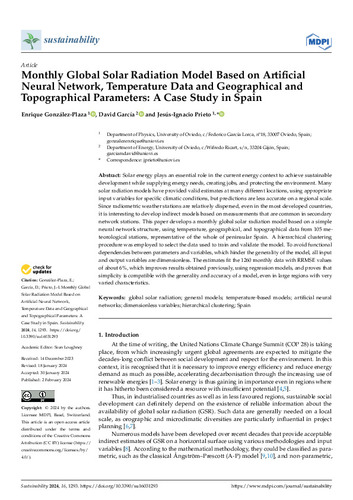Monthly Global Solar Radiation Model Based on Artificial Neural Network, Temperature Data and Geographical and Topographical Parameters: A Case Study in Spain
Autor(es) y otros:
Palabra(s) clave:
global solar radiation
general models
temperature-based models
artificial neural networks
dimensionless variables
hierarchical clustering
Spain
Fecha de publicación:
Editorial:
MDPI
Versión del editor:
Citación:
Resumen:
Solar energy plays an essential role in the current energy context to achieve sustainable development while supplying energy needs, creating jobs, and protecting the environment. Many solar radiation models have provided valid estimates at many different locations, using appropriate input variables for specific climatic conditions, but predictions are less accurate on a regional scale. Since radiometric weather stations are relatively dispersed, even in the most developed countries, it is interesting to develop indirect models based on measurements that are common in secondary network stations. This paper develops a monthly global solar radiation model based on a simple neural network structure, using temperature, geographical, and topographical data from 105 meteorological stations, representative of the whole of peninsular Spain. A hierarchical clustering procedure was employed to select the data used to train and validate the model. To avoid functional dependencies between parameters and variables, which hinder the generality of the model, all input and output variables are dimensionless. The estimates fit the 1260 monthly data with RRMSE values of about 6%, which improves results obtained previously, using regression models, and proves that simplicity is compatible with the generality and accuracy of a model, even in large regions with very varied characteristics.
Solar energy plays an essential role in the current energy context to achieve sustainable development while supplying energy needs, creating jobs, and protecting the environment. Many solar radiation models have provided valid estimates at many different locations, using appropriate input variables for specific climatic conditions, but predictions are less accurate on a regional scale. Since radiometric weather stations are relatively dispersed, even in the most developed countries, it is interesting to develop indirect models based on measurements that are common in secondary network stations. This paper develops a monthly global solar radiation model based on a simple neural network structure, using temperature, geographical, and topographical data from 105 meteorological stations, representative of the whole of peninsular Spain. A hierarchical clustering procedure was employed to select the data used to train and validate the model. To avoid functional dependencies between parameters and variables, which hinder the generality of the model, all input and output variables are dimensionless. The estimates fit the 1260 monthly data with RRMSE values of about 6%, which improves results obtained previously, using regression models, and proves that simplicity is compatible with the generality and accuracy of a model, even in large regions with very varied characteristics.
ISSN:
DOI:
Ficheros en el ítem





